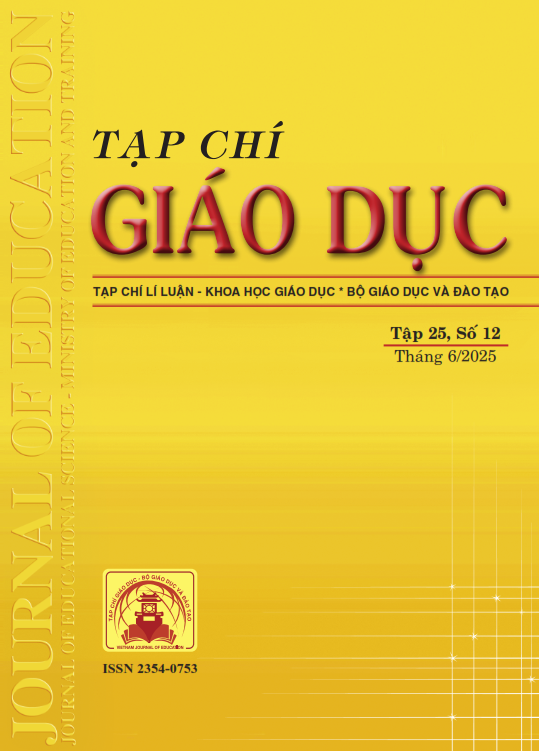Thiết kế và sử dụng web học liệu số theo mô hình học vi mô nhằm phát triển năng lực tự học cho học sinh thông qua dạy học chủ đề “Tốc độ phản ứng” (Hóa học 10)
Tóm tắt
In the current context of education in our country, digital learning materials play an important role in fostering self-study competency among high school students. In this paper, we introduce the foundation and designing process of a digital learning material system based on the micro-learning model “ChemBridge web”. Also, the researchers propose measures for its application in teaching the topic “Reaction Rate” to enhance the self-study competence of 10th-grade students. The study was conducted empirically on 196 students from two high schools in Nghệ An province to measure the results before and after the intervention. The experimental results show that the ES value is 0.79 and the independent t-test value p = 1.56 × 10⁻⁷, indicating a significant impact on students' self-study competence. The findings confirm the effectiveness and feasibility of the digital learning material system based on the micro-learning model “ChemBridge web” in developing students' self-study competence in chemistry education.
Tài liệu tham khảo
Bộ GD-ĐT (2018a). Chương trình giáo dục phổ thông môn Hóa học (ban hành kèm theo Thông tư số 32/2018/TT-BGDĐT ngày 26/12/2018 của Bộ trưởng Bộ GD-ĐT).
Bộ GD-ĐT (2018b). Thông tư số 11/2018/TT-BGDĐT ban hành tiêu chí để xác định hàng hóa chuyên dùng phục vụ trực tiếp cho giáo dục.
Gabrielli, S., Kimani, S., & Catarci, T. (2006). The design of microlearning experiences: a research agenda. In Hug, T., Lindner, M. and Bruck, P.A. (Eds), Microlearning: Emerging Concepts, Practices and Technologies after E-Learning. Proceedings of Microlearning Conference, Learning and Working in New Media, pp. 45-53.
Giurgiu, L. (2017). Microlearning an evolving elearning trend. Scientific Bulletin-Nicolae Balcescu Land Forces Academy, 22(1), 18-23. https://doi.org/10.1515/bsaft-2017-0003
Hug, T. (2005). Microlearning: A new pedagogical challenge. In Microlearning: Emerging Concepts, Practices and Technologies after e-Learning. Proceedings of Microlearning Conference, Innsbruck University Press, pp. 13-18.
Leong, K., Sung, A., Au, D., & Blanchard, C. (2020). A review of the trend of microlearning. Journal of Work-Applied Management, 13(1), 88-102. https://doi.org/10.1108/JWAM-10-2020-0044
Mohammed, G. S., Wakil, K., & Nawroly, S. S. (2018). The effectiveness of microlearning to improve students’ learning ability. International Journal of Educational Research Review, 3(3), 32-38.
Nguyễn Hoàng Trang, Bùi Thị Thơm (2023). Tổ chức dạy học chủ đề “Liên kết hóa học” (Hóa học 10) theo mô hình “Lớp học đảo ngược” nhằm phát triển năng lực tự học cho học sinh. Tạp chí Giáo dục, 23(7), 19-23.
Nguyễn Thị Diễm Hằng (2022). Vận dụng mô hình lớp học đảo ngược để tổ chức dạy học nội dung “Vẽ cấu trúc phân tử” thuộc chuyên đề Thực hành hoá học và công nghệ thông tin - Chuyên đề học tập Hoá học lớp 10 nhằm phát triển năng lực tự học cho học sinh. Tạp chí Giáo dục 22(22), 7-13.
Nguyễn Thị Diễm Hằng, Lê Danh Bình, Bùi Đình Đạt (2024). Sử dụng học liệu số theo mô hình học vi mô (Microlearning) trong dạy học Hóa học lớp 10 - Góc nhìn từ giáo viên Hóa học trường trung học phổ thông. Tạp chí Khoa học Giáo dục Việt Nam, 20(9), 72-78.
Nguyễn Thị Diễm Hằng, Nguyễn Thị Phương Thảo, Phạm Kim Vàng (2024). Xây dựng câu hỏi đánh giá năng lực cho học sinh trong dạy học chủ đề Tốc độ phản ứng (hoá học lớp 10) theo định hướng đề thi tốt nghiệp trung học phổ thông 2025. Tạp chí Giáo dục, 24(16), 24-29.
Nguyễn Thị Phượng Liên, Lưu Thanh Tuấn (2020). Vận dụng mô hình “lớp học đảo ngược” vào dạy học Hoá học hữu cơ (Hoá học 9) nhằm phát triển năng lực tự học cho học sinh. Tạp chí Giáo dục, 479, 13-17.
Nikou, S. (2019). A micro-learning based model to enhance student teachers’ motivation and engagement in blended learning. In Society for Information Technology & Teacher Education International Conference (pp. 509-514). Association for the Advancement of Computing in Education (AACE).
Nikou, S. A., & Economides, A. A. (2018). Mobile‐Based micro‐Learning and Assessment: Impact on learning performance and motivation of high school students. Journal of Computer Assisted Learning, 34(3), 269-278. https://doi.org/10.1111/jcal.12240
Reinhardt, K. S., & Elwood, S. (2019). Promising practices in online training and support: Microlearning and personal learning environments to promote a growth mindset in learners. In Handbook of research on virtual training and mentoring of online instructors (pp. 298-310). IGI Global.
Sung, A., Leong, K., & Cunningham, S. (2020). Emerging technologies in education for sustainable development. In Leal Filho, W., Azul, A., Brandli, L., O€zuyar, P., & Wall, T. (Eds), Partnerships for the Goals. Encyclopedia of the UN Sustainable Development Goals, Springer, Cham.
Tải xuống
Đã Xuất bản
Cách trích dẫn
Số
Chuyên mục
Giấy phép

Tác phẩm này được cấp phép theo Ghi nhận tác giả của Creative Commons Giấy phép quốc tế 4.0 .












